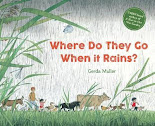So much of the east coast of Australia is experiencing heavy rainfall and we have been stuck in classrooms now for over a week. Australian children are not used to being outside in all weather. They do not have good wet weather gear so instead they stay inside and go 'crazy'. In the library I've had a lot of fun supplying students with books about rain and floods. They are preoccupied with it, especially the boys. There is not a flood book left in the library and once I looked I was surprised just how many we did have.
My favourite flood story is The Useless Donkeys by Lydia Pender and Judith Cowell. Of course its out of print, but the artwork showing the continuous rain is so good. It is set on a farm where the family keep two donkeys, that the children love but dad wants to get rid of. When the floodwaters rise the donkeys end up on an island in the paddock. The oldest two children row to the island to rescue the donkeys.Another favourite that is also out of print is Children of the Yangtze River by Sven Otto S. In this story children need to vacate their school because the river is rising. They move animals and families to higher ground and once the river abates they help rebuild a village.
Here's some other books about floods that are in the library and more easily sourced:
• Flood by Jackie French and Bruce Whatley
• Flood by Alvaro F. Villa
• Flood by Gillian McClure
• Flood Warning by Katharine Kenah and Amy Schimler Safford• Elmer and the Flood by David McKee
And some that just highlight incessant rain without a flood:
• Rain School by James Rumford
• Home in the Rain by Bob Graham
• The Rhythm of the Rain by Grahame Baker-Smith
• Rain by Sam Usher• Singing in the Rain by Tim Hopgood
• Rain! by Linda Ashman and Christian Robinson
• Rain Rain Rivers by Uri Shulevitz
• Who Likes Rain? by Wong Herbert Yee• This Beautiful Day by Richard Jackson and Suzy Lee
• Float by Daniel Miyares
And when a child asks where do the animals go when it rains?
• Where Do They Go When it Rains? by Gerda Muller
• Where Does Kitty Go in the Rain? by Harriet Ziefert and Brigette Barrager
And you'll need to share some poetry:
• It's Raining, It's Pouring by Peter, Paul and Mary and Christine Davenier
• Talking Like the Rain by X.J. and Dorothy M. Kennedy and Jane Dyer
• Listen to the Rain by Bill Martin Jnr and John Archambault













